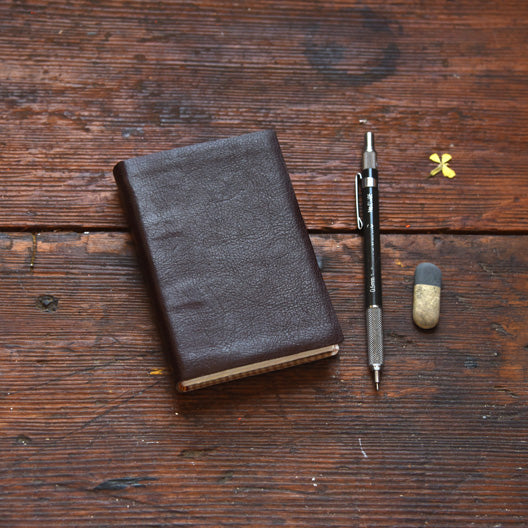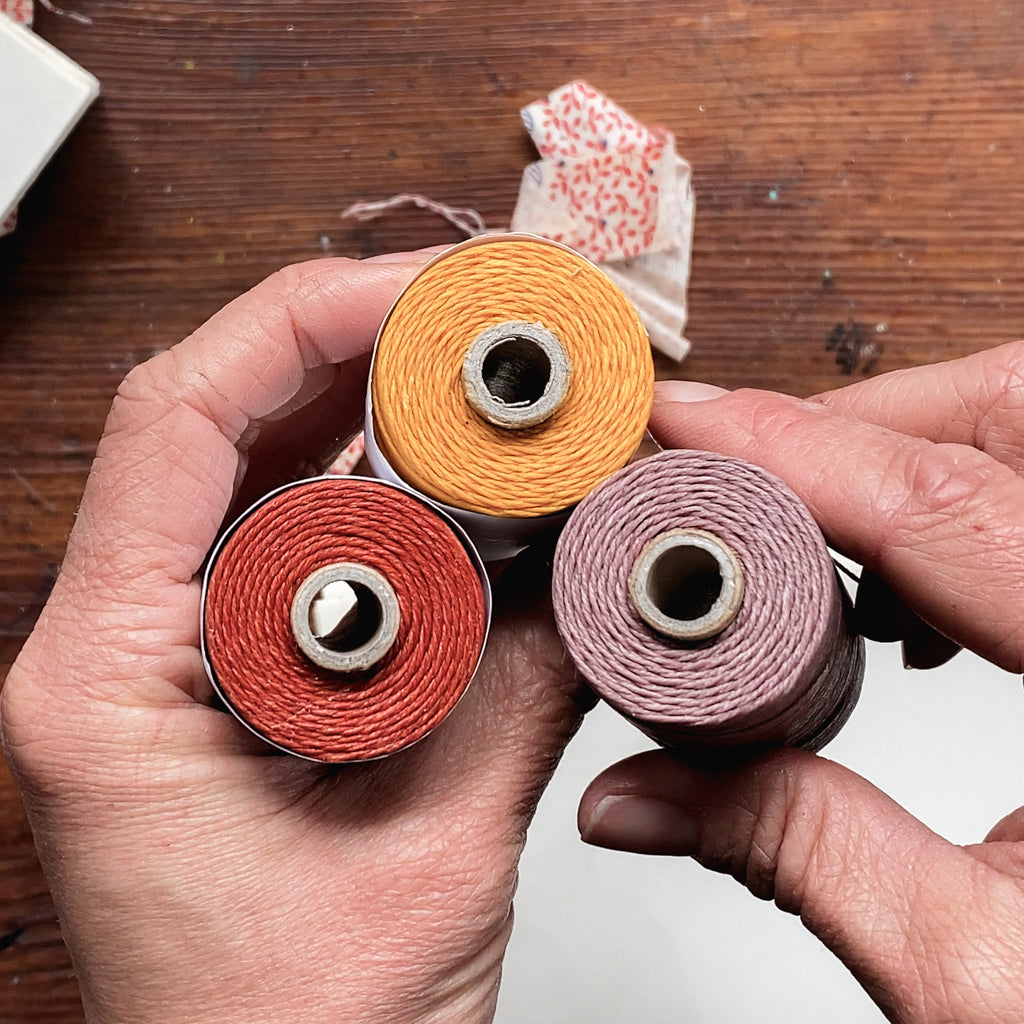Bookbinding at Home Part 3: Covering a Journal with Leather
 |
 |
Here is the last video in our first bookbinding tutorial series: Bookbinding at Home. Thank you all for following along and sharing your books. We are so psyched to see all of the books that have come out of these tutorials! We hope you find comfort in the process of binding your books as well as filling them. There is certainly a lot to document right now— in both pictures and words.
We love seeing your books and sharing in our Instagram stories and posts (@pegandawl) – be sure to use #quarantinebookbindingclub and/or #pegandawlbinds on your social media posts so we can find you!
Project No. 3: Covering a Journal with Leather
Here is what you will need:
Leather – If you have scrap, an old jacket or wallet, anything soft and malleable, have it ready! Scraps of many colors are also available from many sellers on Etsy.
Fabric – This will replace mull (a starched cheesecloth) that will be glued directly to your book block to strengthen your book.
Thread – For the headband. Aim for something thick that will take up space. You can also use a pre-made headband.
Scissors – For trimming your cover. If you are using leather for your cover, make sure they are sharp!
Hammer – For shaping your book block. Be sure it is clean as it will be coming in contact with your paper! (I used a rock hammer and my pages don't hide it!)
Glue – For gluing your leather to the front and back covers of your book. Elmers works!
Heavy Book – This will be your book press! Any heavy book will do, though I find art books (and their dense pages) perfect for the job!
Suggested Blog Posts
-
We put together a little video so you can make your own book for the #100dayproject! Enjoy, ask questions, and share with us on Instagram so we can see your projects too!
We put together a little video so you can make your own book for the #100dayproject! Enjoy, ask questions, and share with us on Instagram so we can see your projects too!
#qbbc100days
#quarantinebookbindingproject
#pegandawlbindsPlease note: this tutorial is specifically about page count. Click here for the full Bookbinding at Home Tutorial: Stitching a Coverless Journal.
In this video, I’m making two books at a time, both specifically made for the 100 day project. They are both the same size with just a few variations. I find this project to be a really nice reason to get out and observe the world.


These are the two journals, highlighting different colors and vintage textiles! Here you can see a full journal spread dedicated to one day! When you’re making a book for a particular project, it’s really important to consider both paper size and page count of your book. I’m making this book for my 100 day project, so I’m going to consider how many pages I will need for the 100 days. Usually, I like to dedicate a full spread to one day, so I’m going to need double the pages, though in some instances, I’ll use one page per day.
Journal Page Planning
If your 100 day project will consist of one spread per day, then you will need 52 sheets, which is the size of one full page spread open. Once you fold a single sheet in half, it’s called a folio. You'll be putting 4 folios inside of each other and that will make up one signature. You will have a total of 13 signatures. That will give you 202 pages, not counting the front and back cover. The few extra pages can come in handy for notes or whatever you may want to add.If you want to make a book that is dedicating one page to a day, then you will need 27 sheets. You’ll be putting 3 folios inside of each other, and that will make up one signature. You will have a total of 9 signatures. And this will give you 106 pages not counting the front and back cover.
Bookbinding GlossarySheet: The unfolded paper pages that you start your project with
Folio: A folded sheet
Signature: Gathering of folios
Leaf: One half of a folded sheet
Page: Each side of each leaf
Now that I’ve finished folding and tearing my signatures, I’m going to measure out where I want the textiles to be sewn onto the spine of the book. I’m going to start with my quarter inch ends – this is for the end knots.

The end knots form lines along the ends. 

Measuring and marking my linen and thread layout on one signature. Then, marking another signature and putting one in front and one in back of the stack. Usually, I would now put these signatures into a clamp, and use a ruler to connect the front and back markings in a straight line. However, if you don't have a clamp, these double-sided marks will help. In the video, you can see how I use a jeweler saw to make the holes, instead of poking them one at a time (once again, for full instructions: Bookbinding Tutorial - How to Sew a Coverless Journal).
Now I am just going to cut some of this wonderful vintage textile that I found in an abandoned house.


I am making the strips an inch wide so they can really show off the pattern. A lot of you have been asking what kind of thread I am using; this is a 3 ply waxed Irish Linen thread. I have 13 of these signatures, and I’m going to measure 13 lengths of wax thread, slightly larger than the length of the spine. I don’t want a lot of extra thread, because the longer your thread is, especially for a big book like this, the more tangled it’s going to get while you’re sewing. Also, if you cut your thread too short so that you have less to manage, you’re going to have to knot it somewhere in your book, which is not a big deal (but I don't like doing it).


This feedsack textile was in a bundle that I found in my favorite abandoned house that belonged to Flossie and Jack. Step-by-step sewing instructions! I have been incorporating antique materials of all kinds into the work that I do for most of my life. I love the stories that they hold, the character, and the quality of these old things. This fascination is what started me off on incorporating textiles into my journals.
My friend and I found all of Flossie’s dresses in the attic of her abandoned house; we washed them and wore them for years. We saw all the evidence of the patching and the stitching as these were likely from the depression era.
This red feedsack was originally stitched together to make a bag for grain, and then people would use the patterns and the normal cotton feedstock textiles to make clothes; so this was most likely the negative space from the pattern that was cut, and then they used a piece to tie the entire bundle together.
I am using this delightful leftover for my journal.


Just one stack of many vintage textiles we’ve used in our projects. Can you spot the vintage touches in these past sketchbooks? I’ve participated in this challenge for the last few years, as it encourages me to make marks daily. Some of the drawings in these sketchbooks took 5 minutes, others took hours. It doesn’t matter how long I spend with each drawing, just that I sat down to make some marks.
In 2021 I used Noodlers Black Ink (with the catfish on the front) and my left (non-dominant) hand for my 100 Day Project. I loved it so much that I've done it for nearly 300 days out of the year - that is three #100dayproject notebooks and a rather newly-skilled left hand!


A finished project. At my desk, with my Sendak Mini and Beatrix Caddies. 

I've been sharing my drawings on my art/family account on Instagram @thebrotherskent. I also write with my left hand. It was such a different experience from my meandering Morning Pages! Planning a Journal for the 100 Day Project
We put together a little video so you can make your own book for the #100dayp...
Read The Post
Suggested Blog Posts
We put together a little video so you can make your own book for the #100dayproject! Enjoy, ask questions, and share with us on Instagram so we can see your projects too!
We put together a little video so you can make your own book for the #100dayproject! Enjoy, ask questions, and share with us on Instagram so we can see your projects too!
#qbbc100days
#quarantinebookbindingproject
#pegandawlbinds
Please note: this tutorial is specifically about page count. Click here for the full Bookbinding at Home Tutorial: Stitching a Coverless Journal.
In this video, I’m making two books at a time, both specifically made for the 100 day project. They are both the same size with just a few variations. I find this project to be a really nice reason to get out and observe the world.
 |
 |
When you’re making a book for a particular project, it’s really important to consider both paper size and page count of your book. I’m making this book for my 100 day project, so I’m going to consider how many pages I will need for the 100 days. Usually, I like to dedicate a full spread to one day, so I’m going to need double the pages, though in some instances, I’ll use one page per day.
Journal Page Planning

If your 100 day project will consist of one spread per day, then you will need 52 sheets, which is the size of one full page spread open. Once you fold a single sheet in half, it’s called a folio. You'll be putting 4 folios inside of each other and that will make up one signature. You will have a total of 13 signatures. That will give you 202 pages, not counting the front and back cover. The few extra pages can come in handy for notes or whatever you may want to add.
If you want to make a book that is dedicating one page to a day, then you will need 27 sheets. You’ll be putting 3 folios inside of each other, and that will make up one signature. You will have a total of 9 signatures. And this will give you 106 pages not counting the front and back cover.
Folio: A folded sheet
Signature: Gathering of folios
Leaf: One half of a folded sheet
Page: Each side of each leaf
Now that I’ve finished folding and tearing my signatures, I’m going to measure out where I want the textiles to be sewn onto the spine of the book. I’m going to start with my quarter inch ends – this is for the end knots.
 |
 |
 |
Usually, I would now put these signatures into a clamp, and use a ruler to connect the front and back markings in a straight line. However, if you don't have a clamp, these double-sided marks will help. In the video, you can see how I use a jeweler saw to make the holes, instead of poking them one at a time (once again, for full instructions: Bookbinding Tutorial - How to Sew a Coverless Journal).
Now I am just going to cut some of this wonderful vintage textile that I found in an abandoned house.
 |
 |
I have 13 of these signatures, and I’m going to measure 13 lengths of wax thread, slightly larger than the length of the spine. I don’t want a lot of extra thread, because the longer your thread is, especially for a big book like this, the more tangled it’s going to get while you’re sewing. Also, if you cut your thread too short so that you have less to manage, you’re going to have to knot it somewhere in your book, which is not a big deal (but I don't like doing it).
 |
 |
I have been incorporating antique materials of all kinds into the work that I do for most of my life. I love the stories that they hold, the character, and the quality of these old things. This fascination is what started me off on incorporating textiles into my journals.
My friend and I found all of Flossie’s dresses in the attic of her abandoned house; we washed them and wore them for years. We saw all the evidence of the patching and the stitching as these were likely from the depression era.
This red feedsack was originally stitched together to make a bag for grain, and then people would use the patterns and the normal cotton feedstock textiles to make clothes; so this was most likely the negative space from the pattern that was cut, and then they used a piece to tie the entire bundle together.
I am using this delightful leftover for my journal.
 |
 |
I’ve participated in this challenge for the last few years, as it encourages me to make marks daily. Some of the drawings in these sketchbooks took 5 minutes, others took hours. It doesn’t matter how long I spend with each drawing, just that I sat down to make some marks.
In 2021 I used Noodlers Black Ink (with the catfish on the front) and my left (non-dominant) hand for my 100 Day Project. I loved it so much that I've done it for nearly 300 days out of the year - that is three #100dayproject notebooks and a rather newly-skilled left hand!
 |
 |
 |
 |
Planning a Journal for the 100 Day Project
We put together a little video so you can make your own book for the #100dayp...
Read The Post







Comments
Margaux Kent
May 17, 2020Thank you all for these sweet comments! So pleased you are enjoying the tutorials. Samantha – yes! You will find your own aesthetic through practice, and Marcela – THAT is amazing!!! Cannot wait to see what you make with the chaps!
Samantha
April 18, 2020Your work is so beautiful, your aesthetic so appealing. Thank you for your generosity. The video tutorial series is really great and I find myself going back just to watch over and over.
My challenge is to find my point of difference, my aesthetic, my style! It’s tough when everything you make speaks so loudly to me! Thank you 😊
Marcela del Toro
April 16, 2020This was a quarantine lifesaver! I cannot thank you enough for these videos! They kept me VERY focused, I learned patience, and produced, when it’s dry, I hope a very cool little journal. I went digging through a barrel of chaps scraps tossed at King’s Saddlery here in Sheridan, WY, and it only cost me 5 dollars. Best investment, ever. Perfect for these times!
Lynn
April 11, 2020Great video! I’ve been wanting to try this, and this video is just the ticket! Thanks!
Jana
April 11, 2020This was such a great series of bookmaking / bookbinding tutorials!! I can’t wait to make my own sketch / watercolor book and am already planning gift possibilities too. You’re a terrific teacher!! xo
Nancy
April 11, 2020I am loving these book making tutorials. They are so clear and easy to follow and the books are beautiful. I will try and start some !! So much to do and soooo much time to work on them. Thank you.
CHeryl oWens
April 11, 2020Always inspiring. Blessings on you and yours
Kathy
April 11, 2020Thanks for this! What a great project, and kudos to your for sharing.
Alison
April 11, 2020Thank you for sharing your expertise. I really enjoyed watching these videos & plan to try to make my own book. I learned some new terminology too! ❤📚
Katerina Kotsona
April 11, 2020Thank you so much for these inspiring bookbinding sessions! I really enjoy them!
Thank you again! Have a nice day!